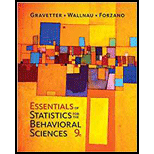
Concept explainers
Data from the Department of Motor Vehicles indicate that 80% of all licensed drivers are older than age 25.
- a. In a sample of n = 50 people who recently received speeding tickets, 33 were older than 25 years and the other 17 were age 25 or younger. Is the age distribution for this sample significantly different from the distribution for the population of licensed drivers? Use α = .05.
- b. In a sample of n = 50 people who recently received parking tickets, 36 were older than 25 years and the other 14 were age 25 or younger. Is the age distribution for this sample significantly different from the distribution for the population of licensed drivers? Use α = .05.
a.
To check: The age distribution for the given sample is significantly different from the distribution for the population of licensed drivers.
Answer to Problem 4P
The age distribution for the given sample is significantly different from the distribution for the population of licensed drivers.
Explanation of Solution
Given info:
In a sample of 50 people who received speeding tickets, 33 were of age 25 and older and 17 were of age 25 and younger. Data from the Department of Motor Vehicles indicate
that 80% of all licensed drivers are older than age 25. Use
Calculations:
Step 1: Null hypothesis and Alternate hypothesis are:
Step 2: For the given sample, degrees of freedom equals:
With
Step 3:
The formula to calculate expected frequency is:
Substituting respective values of proportion and
The contingency table is:
| Frequency | Age 25+ | Age 25- |
| Observed (
|
33 | 17 |
| Expected (
|
40 | 10 |
Finally substitute the values in the
Step 4: Rejection rule: Reject when
Since
Step 5: Based on the results of hypothesis test, there is sufficient evidence to reject the null hypothesis at
Hence, reject null and conclude that the age distribution for the given sample is significantly different from the distribution for the population of licensed drivers.
b.
To check: The age distribution for the given sample is significantly different from the distribution for the population of licensed drivers.
Answer to Problem 4P
The age distribution for the given sample is not significantly different from the distribution for the population of licensed drivers.
Explanation of Solution
Given info:
In a sample of 50 people who received speeding tickets, 36 were of age 25 and older and 14 were of age 25 and younger. Data from the Department of Motor Vehicles indicate
that 80% of all licensed drivers are older than age 25. Use
Calculations:
Step 1: Null Hypothesis and Alternate Hypothesis are:
Step 2: For the given sample, degrees of freedom equals:
With
Step 3:
The formula to calculate expected frequency is:
Substituting respective values of proportion and
The contingency table is:
| Frequency | Age 25+ | Age 25- |
| Observed (
|
36 | 14 |
| Expected (
|
40 | 10 |
Finally substitute the values in the
Step 4: Rejection rule:
Reject when
Since
Step 5: Based on the results of hypothesis test, there is no sufficient evidence to reject the null hypothesis at
Hence, fail to reject null and conclude that the age distribution for the given sample is not significantly different from the distribution for the population of licensed drivers
Want to see more full solutions like this?
Chapter 15 Solutions
Essentials of Statistics for The Behavioral Sciences (MindTap Course List)
 Holt Mcdougal Larson Pre-algebra: Student Edition...AlgebraISBN:9780547587776Author:HOLT MCDOUGALPublisher:HOLT MCDOUGAL
Holt Mcdougal Larson Pre-algebra: Student Edition...AlgebraISBN:9780547587776Author:HOLT MCDOUGALPublisher:HOLT MCDOUGAL Glencoe Algebra 1, Student Edition, 9780079039897...AlgebraISBN:9780079039897Author:CarterPublisher:McGraw Hill
Glencoe Algebra 1, Student Edition, 9780079039897...AlgebraISBN:9780079039897Author:CarterPublisher:McGraw Hill

